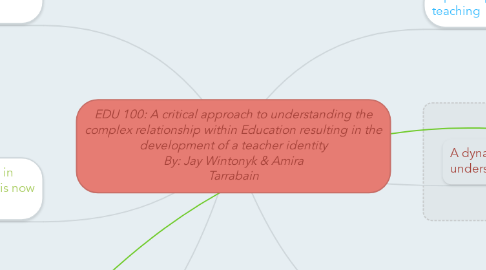
1. A philosophical approach towards teaching
1.1. Picture Book Philosophy (2011): Allowing students the opportunity to ask the 'why' questions within philosophy. Taking a simple children's novel and developing a deeper understanding of what the meaning behind it is and what sorts of teachings can be taken from it.
1.2. The Truth About Stories (2011): Interpreting the telling of stories from a different prospective. How does story telling affect our students? Allowing stories to be interpreted by the students rather than telling them what exactly what the moral of the story is.
1.2.1. Personal Reflection: This encourages students to develop critical thinking skills which will act as a useful tool in the future
2. A dynamic approach towards the understanding of our students
2.1. Inclusive Education Slides: Developing an understanding that all students have diverse learning needs and beginning to think of how we can accommodate these within the classroom.
2.1.1. Personal Reflection: Inclusive education is a positive way to integrate a variety of students within a classroom, this allows students to develop diverse relationships with varying students. This will encourage students to development open-minded perspectives.
3. Professionalism: the high standards that teachers are obliged to follow and how this affects their lives outside of teaching
3.1. Guest speaker: Dr. Mark Yurick - outlined specific aspects about the code of conduct in the Alberta Teacher's Association and noted important considerations with setting appropriate relationships between students. For example, part 18 of the code of conduct states that the teacher is to maintain the dignity of the profession and act accordingly to uphold the honour of being a teacher (ATA, 2004).
3.1.1. Personal Reflection: In my EDPS 410 - ethics class, we spoke a lot about the implications surrounding the ATA's code of conduct and the extremely high standard that teachers are held too. It just makes us rethink all of our behaviours and actions, especially with how closely connected technology and social media has become in our lives
4. How society affects education, connecting this back to our own personal ideologies
4.1. Robinson (2010): There needs to be a shift in education, we need to move away from the 'traditional' methods of teaching and begin to look at the tools that students require to help them within real world situations such as critical thinking, development of social relationships and self-discipline
4.2. McDonough Guest Speaker: Inspiring Education, the reform of education influenced by over 3000 citizens within society, where do we see ourselves in 2030? Changing education from teacher-directed to student-directed learning, a shift in the curriculum
4.2.1. Personal Reflection: I am looking forward to teaching within this new system! It is exciting to see this shift within education as the shift towards a more student-directed learning environment will be beneficial to the students within the classroom
5. How has education in Canada, and specifically in Alberta, changed over time and how does it this now reflected in our pedagogies?
5.1. Through a combination of Federal policy introduction and Neoliberalism in the 1990's, the Klein administration in Alberta paved the way for large social welfare cuts to address provincial Debt (Kachur & Harrison, 1999).
5.1.1. Personal Reflection: I think that some of the policies that were enacted during the Klein administration in the 1990's were beneficial, such as the consolidation of school boards, which was highlighted by our guest speaker Dr. Frank Peters.
5.2. As referenced in Dr. Frank Peters guest lecture, the responsibility of education was given to provincial jurisdictions, and removed from federal government. However, Indigenous education that was agreed to in the Treaties, still remained under Federal control.
5.2.1. Personal Reflection: There is a disconnect between INAC (Indian Northern Affairs Canada) and the province of Alberta with how we collaborate to provide the best education possible with on-reserve schols and public education. Hopefully the new policy "First Nations Control of First Nations Education Act" by the Federal Government, will help set the tone for how First Nations education portrayed and treated.
6. How does Indigenous Education factor into current education models, and how does teaching Indigenous students factor in to Teacher identity and pedagogy?
6.1. It is imperative to build a relationship between teacher and student by engaging in reciprocal knowledge about Indigenous culture and by having the taking the role of the student to create recognition and respect for Indigenous culture (Aikenhead & Mitchell, 2011).
6.1.1. Personal Reflection: It makes sense to realize that we will be teaching Indigenous students at some point in our teaching careers. When Leanne highlighted this fact in her presentation on Indian Residential Schools, we were reminded that our needs as teachers are secondary to that of the student. Our job is to give them the best education possible and this can be achieved by respecting and promoting the culture and values they hold.
